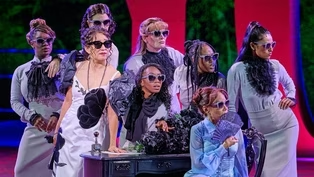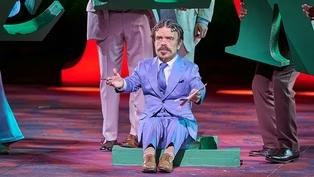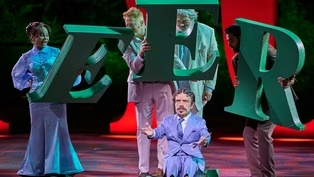
A New Home for Shakespeare in Central Park
Clip: Season 53 Episode 4 | 11m 59sVideo has Closed Captions
Go backstage at the newly revitalized Delacorte Theater in Central Park.
Go backstage at the newly revitalized Delacorte Theater in Central Park, home to Free Shakespeare in the Park. Patrick Willingham (Executive Director of The Public Theater) traces the theater's legacy from Joseph Papp's founding mission to the reopening production of "Twelfth Night."
Problems playing video? | Closed Captioning Feedback
Problems playing video? | Closed Captioning Feedback
Major series funding for GREAT PERFORMANCES is provided by The Joseph & Robert Cornell Memorial Foundation, the Anna-Maria and Stephen Kellen Arts Fund, the LuEsther T. Mertz Charitable Trust, Sue...

A New Home for Shakespeare in Central Park
Clip: Season 53 Episode 4 | 11m 59sVideo has Closed Captions
Go backstage at the newly revitalized Delacorte Theater in Central Park, home to Free Shakespeare in the Park. Patrick Willingham (Executive Director of The Public Theater) traces the theater's legacy from Joseph Papp's founding mission to the reopening production of "Twelfth Night."
Problems playing video? | Closed Captioning Feedback
How to Watch Great Performances
Great Performances is available to stream on pbs.org and the free PBS App, available on iPhone, Apple TV, Android TV, Android smartphones, Amazon Fire TV, Amazon Fire Tablet, Roku, Samsung Smart TV, and Vizio.
Buy Now
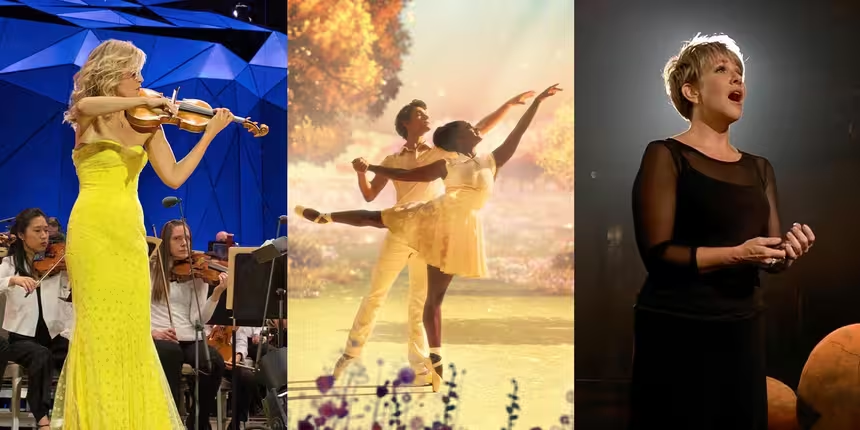
Great Performances Newsletter
Subscribe to the Great Performances newsletter to keep up with the latest full episodes to stream, exclusive content, and more!Providing Support for PBS.org
Learn Moreabout PBS online sponsorshipHi, I'm Patrick Willingham.
I'm the Executive Director of The Public Theater and thrilled to welcome you all to the newly revitalized Delacorte.
♪♪ It doesn't get more unique than the Delacorte.
It's every actors like bucket list dream to grace the Delacorte stage.
I would look at those big flags and I'd be like, I'm going to work there one day.
I'm going to work there one day.
It was my very first job that I was offered in New York City.
I got my equity card doing my show at the Delacorte.
I made my New York debut here when I was 21 years old.
What Shakespeare in the Park is, right?
The communion with all these 2000 people, people who have lined out for, like, hours.
Right?
Put in their, like, their time to be here.
Our founder, Joe Papp, started the New York Shakespeare Festival in the mid-fifties by touring mobile shows around all of New York City.
He would go to parking lots, he would go to Parks, and he also came right here to Central Park.
The myth is that the truck broke down in this location and therefore here we are today.
Not exactly 100% true, but it's a cute story.
So in the late fifties, Robert Moses, who was the somewhat infamous parks commissioner in New York City, decided that Joe and his Shakespeare Festival should charge for admission.
Joe's idea was always that this should be completely free, that the culture belonged to all of us, that there should be no barriers between the audience and the work that he was trying to present.
But Moses felt very strongly that all those people who were coming into the park were actually destroying the park.
And he tried to make a deal with Joe that they should charge $0.50.
He would keep $0.25, and Joe could keep $0.25 per admission in order to both prepare the park and support the productions.
Joe actually took Robert Moses to court, and this story appeared seven times on the front page of The New York Times in 1957 and 1958.
And a judge finally ruled that Moses was acting arbitrarily and capriciously and gave Joe the legal right to produce Shakespeare in the Park here for free.
Within a couple of years.
Moses determined that he should perhaps save a little bit of face and found funding to erect the Delacorte Theater that is behind me now.
That theater was finished in 1962 and welcomed its very first audiences to The Merchant of Venice, starring George C Scott [Man speaks into megaphone] Since early afternoon, the audience has been gathering.
Get your tickets... Tickets are one per person in line.
The crew has been readying the stage.
As evening approaches, the actors leave the 20th century and become members of a royal court.
Many of the fine actors you'll see tonight, the leading performers have appeared in as many plays of Shakespeare on the stage here in Central Park.
So it is quite an event.
Tonight's performance is like any other performance.
It's live, but with a very lively audience, I gather.
And I hope you enjoy it.
Thank you.
Our architect now likes to say it was something of a pop up.
I don't think that Robert Moses or the city thought that Joe Papp and this whole artistic enterprise were going to last very long.
Likely that it was just going to dry up and blow away in five or ten years.
Once we began to renovate the theater, which it needed after 60 some years, we discovered the way that the auditorium was put together was a little bit haphazard.
We really understood that we had to go in and ensure that this space was going to last for generations to come.
The thing that I love about this renovated space is that it feels like the same space that I performed in in 1997, but it feels like it's been brought to the present day.
It was important to us to recreate a space that both felt familiar to what had been here before, but also elevated the overall experience, particularly architecturally here on the outside.
We partnered with any Ennead Architects who we partnered with many, many times for projects at the Public.
They delivered a really extraordinary product.
This was the most significant architectural intervention that the space has had in its six decade life.
We really took everything completely down to the studs.
We think of it as our brownstone gut renovation and really rebuilt on top of the old structure and part that was because of the type of alteration, regulations that we were working under.
We couldn't increase the footprint at all.
So our architects did a very clever move.
They canted the facade so that it leans out at the top, makes it both a little bit more dynamic, but also allowed us to add an entire row of seats in the back of the house, which then allowed us to increase the accessibility while not decreasing the number of seats that we have.
The facade of the theater is actually made out of reclaimed water tower redwood.
So every 30 or 40 years, those water towers that you see on the top of city buildings get decommissioned.
And about ten years ago, a couple of companies started reclaiming that wood and reuse it for sites like this.
So there's nothing really romantic about that idea that the facade is covered by redwood from all around the city.
We think of this as the people's theater, as the city's theater, and that just sort of brings that right home.
♪♪ The theater is designed as a very classic amphitheater style.
It's a very wide half circle, which means essentially for a 2000 seat theater, there's not a bad seat in the house.
No matter where you're sitting.
You feel like you're as close to the action as anyone else.
So the most important thing to us about the experience of Shakespeare in the Park was something that we wanted to make sure that we did not mess up in any way.
There's nothing like sitting out in the middle of Central Park under the sky, geese flying past the moon.
So the experience for the audience is going to feel extraordinarily similar.
Some differences, you know, we've definitely made the seats quite a bit larger.
They were much more narrow from 1962.
And so the new renovation has allowed us to actually create a little bit more room for folks.
We've also really increased accessibility.
So before, if you use a wheelchair had other mobility issues, you could only sit in the very front row of the theater.
We've created a whole center aisle.
We've increased the number of audience ramps as well.
We have two audience ramps, whereas before we only had one, both of which are completely ADA accessible and get you to the best seats in the house.
♪♪ So our biggest improvements were to a lot of the infrastructure here.
The lighting towers have been replaced.
Now a lot of the cabling, the cords are all built into that structure before they were done by hand each and every year.
Instruments, lighting instruments were hold up by hand.
Now they're winches.
Underneath the grandstand, we have an entirely climate controlled condition.
It used to essentially be an open air space.
We've now enclosed as much of that space as possible so that for the folks who are working here can be far more comfortable.
They're not outside in 100 degree temperature and 90% humidity.
We're the Public Theater.
And so we had to be as accessible as possible in every way, whether it be about mobility, whether it be about age.
We wanted to ensure that anyone who either wanted to participate in this program by being an audience member or participate by being a stage stage technician or a designer director or an actor was able to access as much of the theater as possible.
For our artists who work here, the experience of their dressing rooms has been completely upgraded.
They used to be old cinder block walls, concrete floors, literally leaking ceilings, Formica countertops and bathrooms that were marginal at best.
The dressing rooms were pretty crummy before.
I have been in those spaces before there was air conditioning.
I've been in those spaces.
When they decided to try and slap some air conditioning into that space.
And now I've been into the space where they've actually really made it comfortable for us.
And this version of the dressing rooms is by far the nicest to be.
It gives the space for the actors to actually retreat to so that they can come out and do their best work for the audiences.
Also, the dressing rooms are now completely accessible.
They were not accessible before, so if you used a wheelchair, you weren't able to perform here very easily.
Now, four of our dressing rooms are wheelchair accessible.
We have a shower that's wheelchair accessible, and the bathrooms are also wheelchair accessible.
We also have notification system so that folks who may have hearing issues are able to interact more easily with the rest of the team.
We also have a production booth that is now accessible to anyone who wants to work here Prior to this, unless you could walk up all of these stairs, you weren't able to work in that booth.
Now we've actually put a lift that goes from the ground floor all the way up to the control booth.
It's completely conditioned and everybody is so excited to be working in it.
We've been working with great performances since 1973 when King Lear was filmed, but most recently, this is our fifth recent collaboration with Great Performances, starting with “Much Ado About Nothing,” Going on to “Merry Wives,” “Richard III,” “Hamlet” and now “Twelfth Night.” We really love our relationship with public television, Public Theater, public television.
There's just a real connection of mission there and are delighted to be once again partnering with them.
Free Shakespeare in the Park is just such an incredible expression of this idea that the culture belongs to everyone.
And as we were fundraising to rebuild this theater, I got to sit with folks who had been experiencing this program for the entirety of its 60 years, sometimes less.
But they all had these beautiful stories to tell from the donors to our government partners.
Everyone has had an experience here.
It is just such a New York City tradition.
And that idea is not even about the shows.
Sometimes it's about they got rained on or they saw a raccoon on stage or they met someone who they're still in touch with sitting on the line.
It really is about this incredible civic communal experience.
♪♪ Thank you for joining us.
We're really excited to welcome you to the Delacorte Theater, either here in New York City or on PBS.
Our revels now are ended.
These are actors, as I foretold you, we're all spirits and are melted into air, into thin air.
And like the faceless fabric of this vision, the cloud capped towers, the gorgeous palaces, the solemn temples, nay, the great globe itself, all which it inherits, shall dissolve.
And like this insubstantial pageant, faded.
Leave not a rack behind.
We are such stuff as dreams are made on and our little life is rounded with a sleep.
Cesario (Lupita Nyong'o) vs Aguecheek (Jesse Tyler Ferguson)
Video has Closed Captions
Clip: S53 Ep4 | 2m 46s | Sir Toby Belch orchestrates a boxing match between two unwilling participants. (2m 46s)
Video has Closed Captions
Clip: S53 Ep4 | 3m 3s | Cesario (Lupita Nyong'o) tries to woo Olivia (Sandra Oh) on behalf of her lord. (3m 3s)
Malvolio (Peter Dinklage) Attempts to Woo Olivia (Sandra Oh)
Video has Closed Captions
Clip: S53 Ep4 | 2m 45s | Malvolio (Peter Dinklage) attempts to woo Olivia (Sandra Oh). (2m 45s)
Orsino enlists "Cesario" to help him woo Olivia
Video has Closed Captions
Clip: S53 Ep4 | 2m 19s | Orsino (Khris Davis) enlists "Cesario" (Lupita Nyong’o) to help him woo Olivia. (2m 19s)
Video has Closed Captions
Preview: S53 Ep4 | 30s | The Shakespearean comedy of mistaken identity tells the misadventures of Sebastian and Viola. (30s)
Providing Support for PBS.org
Learn Moreabout PBS online sponsorship

- Arts and Music

Music for the Christmas season featuring the Choirs and Orchestra of St. Olaf College.






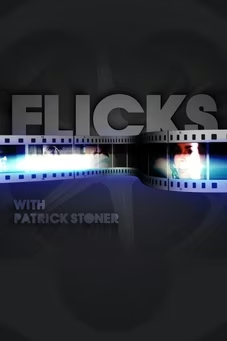





Support for PBS provided by:
Major series funding for GREAT PERFORMANCES is provided by The Joseph & Robert Cornell Memorial Foundation, the Anna-Maria and Stephen Kellen Arts Fund, the LuEsther T. Mertz Charitable Trust, Sue...

